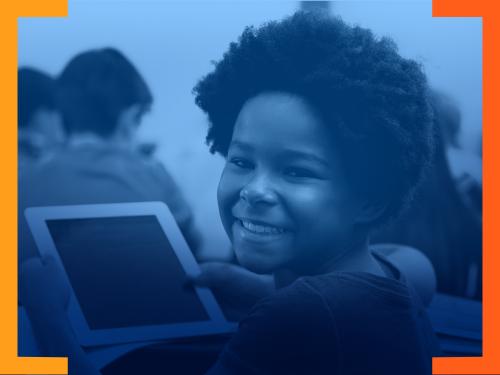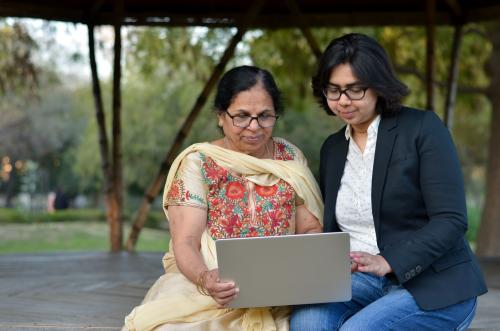This blog summarizes the report, “Ed tech and educational opportunity during the COVID-19 school closures: A case study of Chennai, Tamil Nadu.”
India has been one of the hardest-hit countries by COVID-19. Beyond the staggering impact on human life, COVID-19 has greatly disrupted access to education in India, with 247 million primary and secondary school students out of school. While school systems in India and across the world have made efforts to reach students at home through various means, recent estimates of the impact on learning and socio-emotional well-being suggest that the poorest children will be hurt the most by the pandemic-related school closures.
Indeed, school closures have compelled education systems to quickly devise and apply different modes of remote learning such as radio, TV, and various other types of online tools. But access to this education technology (ed tech) differs across and within countries—with students in high-income countries and communities much more likely to have access to online, virtual schooling than their peers in low- and middle-income countries and communities. Thus, an important question is to what extent will student learning and progression in school, especially among primary-school-aged children in low- and middle-income settings, be affected by the global school closures? Further, how will the COVID-19 school closures cause inequality in learning among girls and boys, among poor and affluent children, and across communities and countries of varying income levels?
To answer these questions, we conducted a household survey in February of this year in a southern city of India—Chennai in the state of Tamil Nadu—with financial support from the Asian Development Bank and in collaboration with J-PAL-India. Chennai is the largest urban center in Tamil Nadu and is India’s sixth most populous city. Due to Chennai’s dense population, families typically have several nearby private and government school options, which provide a ripe setting to explore how the use of ed tech differed between different types of schools—both prior to and during the COVID-19 pandemic. Additionally, India offers a fertile environment for this study’s data collection as a leader in large-scale education reform and ed-tech application among developing countries. The diversity in its large population offers useful lessons applicable to many different contexts.
Alarmingly, 1 in 5 children in our sample were enrolled in schools that do not offer any remote instruction during the school closures, and even among the children whose schools had begun remote instruction, only slightly more than half attended all the classes.
Our goal was to get a better picture of primary school-aged children’s daily educational experiences during the COVID-19 school closures, and especially how students and teachers are using ed tech. We were particularly interested in understanding how these learning experiences may differ among children from low- and high-income households and between children attending private and government (publicly funded) schools.
Our survey findings
Alarmingly, 1 in 5 children in our sample were enrolled in schools that do not offer any remote instruction during the school closures, and even among the children whose schools had begun remote instruction, only slightly more than half attended all the classes.
Our findings further indicate that during the pandemic-related school closures, students in private schools and those from households with high socioeconomic status (SES) have more access to digital devices and are more engaged in regular educational activities than their peers in government schools and from low-SES households. As Figures 1 and 2 show, children enrolled in private schools and from high-SES households had higher rates of access to digital devices—such as smartphones, internet, and computers/laptops—than their peers in government schools and from low-SES households. These preliminary results shed light onto a likely growing inequality of educational opportunity and suggest the need for policymakers to support access to regular learning opportunities at home for children from low-SES households in government and private schools. Other emerging evidence from the COVID-19 school closures suggests that ensuring students have access to even low-tech interventions, such as SMS text messages and phone calls, can help mitigate the potential learning losses.
Figure 1. Share of students with access to educational resources, by household income
 Source: February 2021 Brookings phone survey.
Source: February 2021 Brookings phone survey.
Figure 2. Share of students with access to educational resources, by school type
 Source: February 2021 Brookings phone survey.
Source: February 2021 Brookings phone survey.
Prior research has shown that the impact of school closures in low-income countries may differ by gender, as girls are often expected to help out with household chores and/or assist parents in caring for younger siblings. However, our study shows an encouraging pattern, where girls are more likely than boys to have access to digital devices for learning and to engage in more regular educational activities (see Figures 3 and 4). Nevertheless, this finding suggests the need for further analysis into why boys may be losing out on educational opportunities, and what strategies may be most effective to increase learning among both girls and boys in India and other low-income countries.
Figures 3. Share of students with access to educational resources, by gender
 Source: February 2021 Brookings phone survey.
Source: February 2021 Brookings phone survey.
Figure 4. Frequency of engagement in educational activities, by gender
 Source: February 2021 Brookings phone survey.
Source: February 2021 Brookings phone survey.
Altogether, these preliminary results shed light onto a likely growing inequality of educational opportunity in India and around the world, suggesting the need for policymakers to broaden access to continuous and equitable learning opportunities across the student population.
Looking ahead, it will be crucial for governments to enact strategies to help students recover from the learning losses suffered during the school closures and to return to school. Such a strategy may include:
- Working closely with the health authorities, plan to reopen schools safely as soon as possible.
- Assess each child’s foundational literacy and numeracy skills as soon as possible to help teachers and parents develop personalized interventions to ensure that each child can get back on track to develop these critical skills.
- Expand access to digital devices and connectivity among educators and students, along with guidance and support to teachers on ed-tech resources that are best aligned to each student’s learning level. While ed tech is not alone going to ensure children learn, it can be a tool for educators, students, and parents to facilitate learning continuity during school closures and allow for more student-centered, engaging instruction in and outside the classroom.
- Provide socio-emotional support to educators and students, recognizing that the pandemic has not only caused learning loss but also emotional trauma in too many households.
You can access the full report here.
-
Acknowledgements and disclosures
Sunhwa Lee is a principal social sector specialist and Unika Shrestha is a social sector economist at the Asian Development Bank, which provides financial support for the Center for Universal Education.
The Brookings Institution is a nonprofit organization devoted to independent research and policy solutions. Its mission is to conduct high-quality, independent research and, based on that research, to provide innovative, practical recommendations for policymakers and the public. The conclusions and recommendations of any Brookings publication are solely those of its author(s), and do not reflect the views of the Institution, its management and other scholars, nor the views of its donors, officers, employees, or Board of Trustees.
Brookings gratefully acknowledges the financial support provided by the Asian Development Bank. Brookings recognizes that the value it provides is in its commitment to quality, independence, and impact. Activities supported by its donors reflect this commitment.
The Brookings Institution is committed to quality, independence, and impact.
We are supported by a diverse array of funders. In line with our values and policies, each Brookings publication represents the sole views of its author(s).








Commentary
How has education technology impacted student learning in India during COVID-19?
August 23, 2021